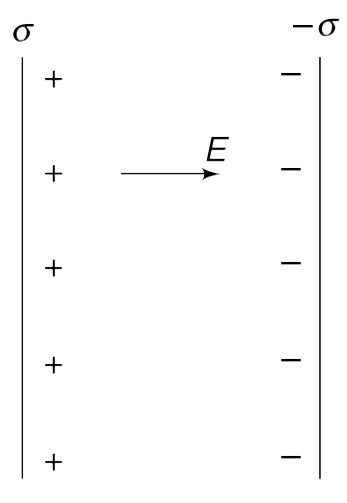Two students A and B were taught that electric field near a uniformly charged large surface is normal to the surface and is equal to σ2∈0. They were also told that field near the surface of a conductor is σ∈0 normal to the conductor where s is charge density on the conductor surface. Now both of them were asked to write field between the plates of an ideal parallel plate capacitor having charge density σ and −σ on its plates. Student A said that field can be seen as superposition of field due to two large charged surfaces. He wrote the answer as
E=σ2∈0+σ2∈0=σ∈0
Student B thought that a capacitor has conducting plates and therefore field due to each plate
Must be σ∈0 . He wrote his answer as E=σ∈0+σ∈0=2σ∈0
Who is wrong and where is the flaw in thinking ?

The correct Answer is:B is wrong
Step by step video, text & image solution for Two students A and B were taught that electric field near a uniformly charged large surface is normal to the surface and is equal to (sigma)/(2 in_(0)). They were also told that field near the surface of a conductor is (sigma)/(in_(0)) normal to the conductor where s is charge density on the conductor surface. Now both of them were asked to write field between the plates of an ideal parallel plate capacitor having charge density sigma and -sigma on its plates. Student A said that field can be seen as superposition of field due to two large charged surfaces. He wrote the answer as E=(sigma)/(2in_(0))+(sigma)/(2in_(0))=(sigma)/(in_(0)) Student B thought that a capacitor has conducting plates and therefore field due to each plate Must be (sigma)/(in_(0)) . He wrote his answer as E=(sigma)/(in_(0))+(sigma)/(in_(0))=(2sigma)/(in_(0)) Who is wrong and where is the flaw in thinking ? by Physics experts to help you in doubts & scoring excellent marks in Class 12 exams.
Updated on:21/07/2023Topper's Solved these Questions
Similar Questions
Knowledge Check
Electric dipole is placed near a uniformly charged large non-conducting surface.
ANet electric force on electric dipole is zero.BNet torque on electric dipole may be zero.CNet torque on electric dipole may be non-zeroDNet electric force on electric dipole may be non-zero.The electric intensity at a pont near a charged conductor having a charge density σ is
Aσ4kε0Bσ2kε0C2σkε0Dσkε0The surface charge densities on two square plates of a parallel plate capacitor are to +σand−σ respectively. What is the magnitude of the electric field in the region between the plates?
Aσ2ε0Bσε0C0DNone of these
Show that the electric field at the surface of a charged conductor is proportional to the surface charge density.
View SolutionWhat is the direction of the electric field at the surface of a charged conductor having charge density σ <0?
View SolutionElectric field at the centre of uniformly charge hemispherical shell of surface charge density σ is σnε0 then find the value of n.

View SolutionWhat is electric field near the surface of a non-conducting charged surface?
View SolutionThe electric field near a conducting surface having a uniform surface charge denstiy σ is given by
View Solution
